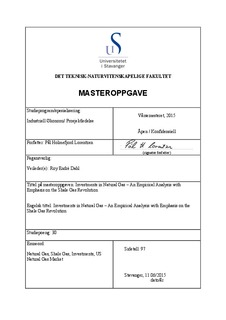| dc.contributor.author | Lorentzen, Pål Holmefjord | |
| dc.date.accessioned | 2015-09-25T08:19:02Z | |
| dc.date.available | 2015-09-25T08:19:02Z | |
| dc.date.issued | 2015-06-15 | |
| dc.identifier.uri | http://hdl.handle.net/11250/301937 | |
| dc.description | Master's thesis in Industrial economics | nb_NO |
| dc.description.abstract | The main objective in this thesis is to investigate how various factors are influencing investments in the US natural gas industry. The thesis puts a special emphasis on the “Shale Gas Revolution” that struck the US natural gas market in 2006/2007 and how it has affected investments in natural gas. The yearly growth rate in shale gas production from 2007-2013 was 31 %. The analysis is based on data from the period 1990-2013. The thesis gives an overview of the US natural gas market and its participants, competition and price formation. Different methods are applied in the analysis. Investment theory and the Net Present Value (NPV) formula are used as a framework to identify and describe important variables and how they have developed in the period 1990-2013. Based on this, the thesis shows how the variables influences the Net Present Value of a natural gas project and thereby the willingness to invest in the natural gas industry. Two linear regression models are applied in the analysis. The objective of the first model is to test whether the shale gas revolution has influenced the investment pattern in the natural gas industry. The objective of the second model is to quantify and explain how various economic variables are linked together and how they influence the investments in natural gas in the US.
The findings are as follows: The empirical analysis confirms that the investments in natural gas industry are positively correlated with; growth in the US- economy (represented by Gross Domestic Product), demand for gas, the price of gas, technological development and proven reserves. The analysis also shows that the shale gas revolution has had a significantly positive effect on investments since its occurrence in 2006/2007. The price of oil has also a strong positive effect on investments, but as the price of oil and the price of gas became more delinked following the shale revolution and the financial crisis in 2009, it is reasonable to assume a weaker correlation between the price of oil and investments in natural gas after 2009. I also find that the shale gas revolution has had a significantly positive impact on investments since its occurrence in 2006/2007. The regression model also indicates that the investments are negatively correlated with the cost of capital, represented by the interest rate on the 10- year US Treasury bond. | nb_NO |
| dc.language.iso | eng | nb_NO |
| dc.publisher | University of Stavanger, Norway | nb_NO |
| dc.relation.ispartofseries | Masteroppgave/UIS-TN-IØRP/2015; | |
| dc.rights | Navngivelse-Ikkekommersiell-IngenBearbeidelse 3.0 Norge | * |
| dc.rights.uri | http://creativecommons.org/licenses/by-nc-nd/3.0/no/ | * |
| dc.subject | industriell økonomi | nb_NO |
| dc.subject | natural gas | nb_NO |
| dc.subject | shale gas | nb_NO |
| dc.subject | investments | nb_NO |
| dc.subject | US natural gas market | nb_NO |
| dc.subject | prosjektledelse | nb_NO |
| dc.title | Investments in natural gas - an empirical analysis with emphasis on the shale gas revolution | nb_NO |
| dc.type | Master thesis | nb_NO |
| dc.subject.nsi | VDP::Social science: 200::Economics: 210::Economics: 212 | nb_NO |

